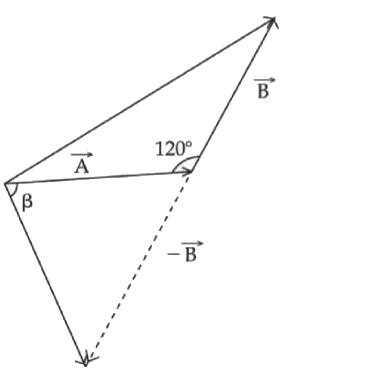The vector →a+→b bisects the angle between the vectors ˆaandˆb if (A) |→a|+∣∣→b∣∣=0 (B) angle between →aand→b is zero (C) |→a|=∣∣→b∣∣=0 (D) none of these
Text Solution
We know that vector →a+→b is along the diagonal of the parallelogram whose adjacent sides are vectors →aand→b. Now if →a+→b bisects the angle between vectors →aand→b, then the parallelogram must be a rhombus , hence, |→a|=∣∣→b∣∣.
|
Topper's Solved these Questions
- INTRODUCTION TO VECTORS BOOK - CENGAGE PUBLICATIONCHAPTER - INTRODUCTION TO VECTORS EXERCISE - ILLUSTRATION 2
1 Videos
- INTRODUCTION TO VECTORS BOOK - CENGAGE PUBLICATIONCHAPTER - INTRODUCTION TO VECTORS EXERCISE - ILLUSTRATION 3
1 Videos
- INTEGRALSBOOK - CENGAGE PUBLICATIONCHAPTER - INTEGRALSEXERCISE - All Questions
762 Videos
- INVERSE TRIGONOMETRIC FUNCTIONSBOOK - CENGAGE PUBLICATIONCHAPTER - INVERSE TRIGONOMETRIC FUNCTIONSEXERCISE - All Questions
541 Videos
Similar Questions
Knowledge Check
The angle between the two vectors →a+→b and →a−→b is
ABetween 0∘ and 180∘B90∘ onlyC0∘ onlyD180∘ onlyLet →aand→b are two vectors inclined at an angle of 60∘,If|→a|=∣∣→b∣∣=2 ,the the angle between →aand→a+→b is
A30∘B60∘C45∘Dnone of theseIf →aand→b are two vector with |→a|=∣∣→b∣∣ and ∣∣→a+→b∣∣+2|→a|,then angle between →a and →b.
A0∘B90∘C60∘D180∘
If →a and →b are any two vectors such ∣∣→a+→b∣∣=∣∣→a−→b∣∣ find the angle between →a and →b
View SolutionIf →aand→b are two nonzero vectors such that ∣∣→a×→b∣∣=→a.→b then find the angle between →aand→b.
View SolutionFor two vectors →aand→b,→a,→b=|→a|∣∣→b∣∣ then (A) →a∣∣→b (B) →a⊥→b (C) →a=→b (D) none of these
View SolutionFor two vectors →aand→b,→a,→b=|→a|∣∣→b∣∣ then (A) →a∣∣→b (B) →a⊥→b (C) →a=→b (D) none of these
View SolutionIf θ is the angle between any two vectors →aand→b, then ∣∣→a.→b∣∣=∣∣→a×→b∣∣ when θ is equal to
View Solution

